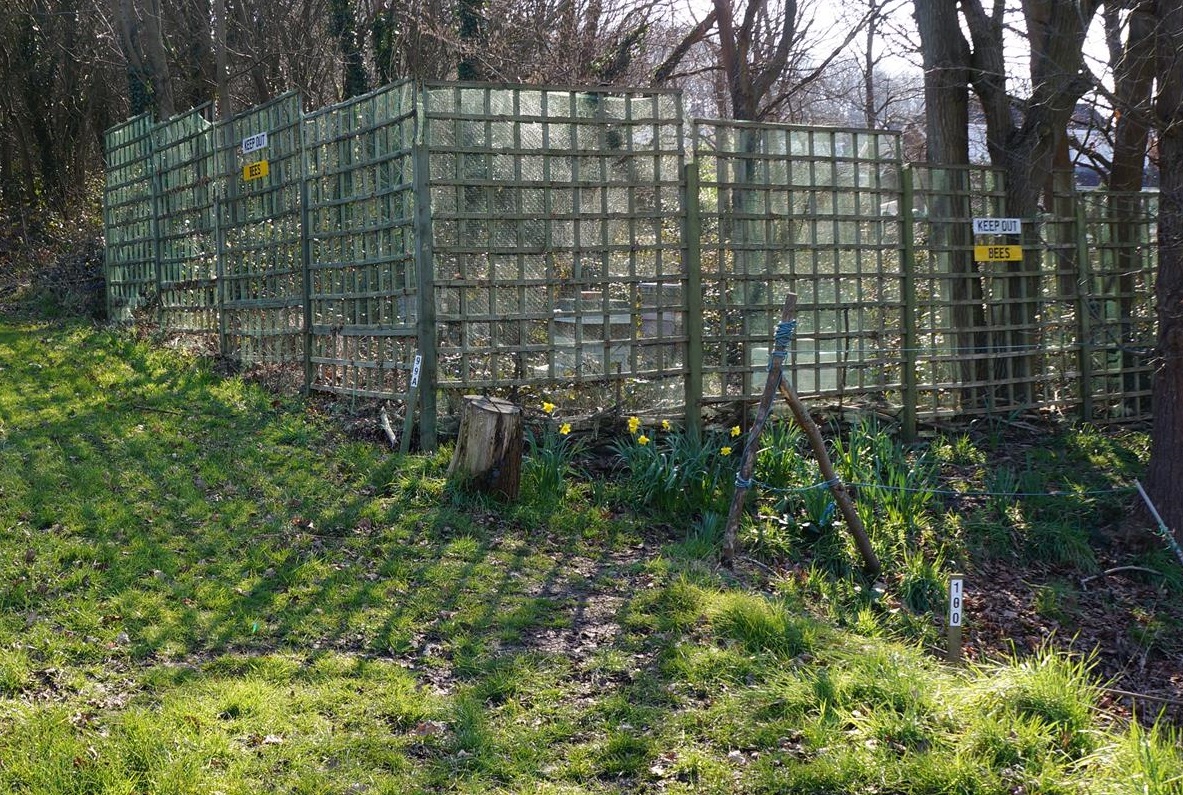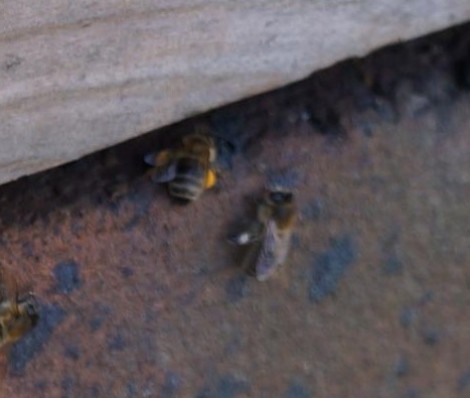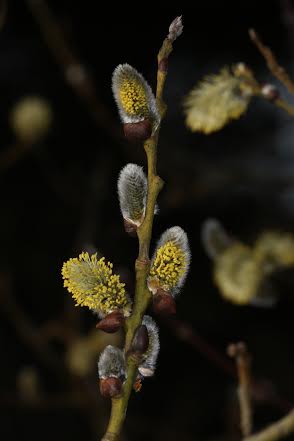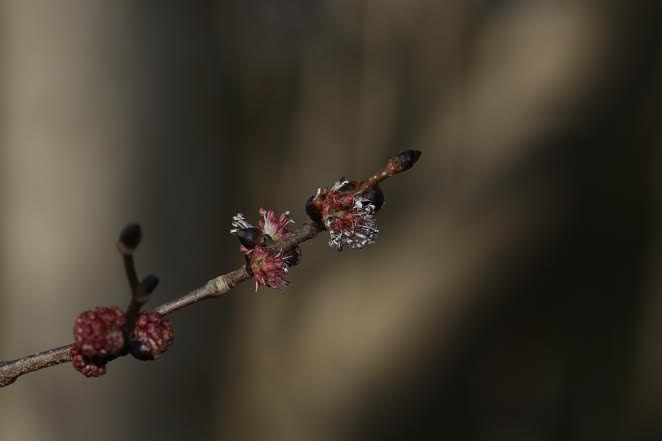 Abraham Lincoln
If given the truth, the people can be depended upon to meet any national crisis...
Abraham Lincoln
If given the truth, the people can be depended upon to meet any national crisis...
 Guildford news...
for Guildford people, brought to you by Guildford reporters - Guildford's own news service
Guildford news...
for Guildford people, brought to you by Guildford reporters - Guildford's own news service
Beekeeper’s Notes April 2016: No Pensions For Bees
Published on: 1 Apr, 2016
Updated on: 5 Apr, 2016
Hugh Coakley keeps bees in Worplesdon and talks about the new beekeeeping season and the bees working until they drop in his monthly series.
My bees, thank goodness, look to have got through the winter.
The two hives in my garden are very active, especially the polystyrene hive which stands in a sunny spot.

Busy hive entrance on a warm, sunny day in early March. Click on the photo to enlarge it. You can see pollen coming in on the bee’s back legs – a sign that the queen is likely to be laying.
Pollen has been coming in now on any days that the bees have been able to fly. That is a positive sign that the queen is doing her job and laying eggs for the next bee generation. Thank you queens.
On the allotment where I have three hives, it is quite shady and surrounded by active plots and gardens. So a different situation to the garden. Bees are woodland creatures so, even though it gets less sun, these cold- blooded creatures seem to do ok there.

Shady allotment apiary site but the bees like it. The screens encourage the bees to fly above head height when they leave the hive to go out foraging. They are less likely to annoy my lovely allotment neighbours than if they were buzzing along bumping into humans.
Two of my three hives look to be doing what they should be doing, active when the weather allows and bringing in plenty of pollen to feed the eggs that the queen is laying.
The fate of the third hive hangs in the balance. The queen is laying, but the numbers of bees in the colony is low after the winter. We shall see what happens.
It is a hard time for the bees who are reaching the end of their short lives now having survived the winter. Workers bees can live for months over the winter period but the older bees are dying off now.

Pollen coming into the hive. But one of the bees in the photo is dead. The bee carrying the yellow pollen got home but died before she could climb back in the hive.
The bee with the yellow pollen on her legs is dead. She had managed to get back to base but wasn’t quite able to get back into the hive. Bees work until they drop. No long life on a pension for bees.
The other bee next to her is carrying a grey-coloured pollen which could be maple or elm. The yellow-coloured pollen could be a number of plants including willow.
Not all colonies have survived the winter though.
My friend, who runs nine hives in various locations, has lost five of them. It is not clear why but it could be a combination of the bees running out of food at a crucial time or simply running out of a critical mass of bees as they die off over the winter.
Hard for the beekeeper but even harder for the bees.
Beekeeping is not all sad stories. It has its ups and downs. But I do get a thrill when I open up my hives for the first time in a season and get a first glimpse of a big, beautiful queen.
Another beekeeping year starts.
Dragon reader Harry Eve has sent these photos in and says:
“I have much appreciation for The Dragon and Hugh Coakley’s contributions.
“Determining the source of the pollen from its colour is particularly fascinating.
“Willow and Wych Elm have both been in flower in our borough over the last week or so. Here are a couple of photos taken at The Sheepleas.”
Responses to Beekeeper’s Notes April 2016: No Pensions For Bees
Leave a Comment Cancel reply
Please see our comments policy. All comments are moderated and may take time to appear. Full names, or at least initial and surname, must be given.Recent Articles
- ‘Help Us To Track Wildlife This Autumn’ – Surrey Charity’s Plea To Nature Lovers
- Letter: Are Vendor-linked Awards the Way to Go for Schools’ ICT?
- Letter: How Not to Engage the Public
- GBC Takes Legal Action Over Unauthorised Bramley Traveller Site
- Developers Release Early Plans For 950 Homes on Normandy Farmland
- Open Day at Silverbirch House Care Home and a Special Gift for One of its Residents
- Birdwatcher’s Diary No.336
- Behind The Picture Of Wealth and Prosperity – Surrey Has a Story of Inequality and Poverty
- Guildford Fringe Founder Steps In To Save The Electric Theatre
- Letter: How Residents Can Take Part in Talks About the Ash Neighbourhood Plan



Recent Comments
- Tony Harrison on Letter: Why Can’t Waverley Council Respond to My Freedom of Information Request Regarding CIL?
- Chris Moore on YouGov Poll Suggests Hunt Could Lose Godalming and Ash to the Lib Dems
- Ricky Sonn on Incident Near Surbiton Disrupting All Rail Services Between Guildford and Waterloo
- Marcia Delaney on Guildford Fringe Founder Steps In To Save The Electric Theatre
- Martin Elliott on Letter: Area Near Walnut Bridge Continues to Be an Embarrassment
- Anthony Mallard on Surrey Police Sergeant Caught Hiding Pub’s Card Machine Given Final Warning
Search in Site
Media Gallery
Cllr Townsend on Waverley’s CIL Issue
August 27, 2025 / Comments Off on Cllr Townsend on Waverley’s CIL Issue / Read MoreMP Zöe Franklin Reviews Topical Issues
August 27, 2025 / Comments Off on MP Zöe Franklin Reviews Topical Issues / Read MoreMP Hopes Thames Water Fine Will Be ‘Final Nail in Its Coffin’
August 27, 2025 / Comments Off on MP Hopes Thames Water Fine Will Be ‘Final Nail in Its Coffin’ / Read MoreNew Guildford Mayor Howard Smith
August 27, 2025 / Comments Off on New Guildford Mayor Howard Smith / Read MoreA New Scene for a Guildford Street
August 27, 2025 / Comments Off on A New Scene for a Guildford Street / Read MoreDragon Interview: Sir Jeremy Hunt MP on His Knighthood and Some Local Issues
August 27, 2025 / Comments Off on Dragon Interview: Sir Jeremy Hunt MP on His Knighthood and Some Local Issues / Read MoreDragon Interview: Paul Follows Admits He Should Not Have Used the Word ‘Skewed’
August 27, 2025 / Comments Off on Dragon Interview: Paul Follows Admits He Should Not Have Used the Word ‘Skewed’ / Read MoreDragon Interview: Will Forster MP On His Recent Visit to Ukraine
August 27, 2025 / No Comment / Read MoreDragon Interview: Fiona Davidson on the ‘Devolution’ Proposals for Surrey
August 27, 2025 / No Comment / Read More













Harry Eve
April 3, 2016 at 6:07 am
I think the willow is Salix caprea but am happy to be corrected. Elm flowers are much less spectacular than the seeds they produce later.
Mr Coakley’s fascinating article reminded me that, among the many non-social mining bees, there is one particular species that is very rare in Surrey and lives in the east of Guildford Borough. It collects from mainly one kind of wild flower and the pollen is salmon-pink in colour giving it a very distinctive appearance.